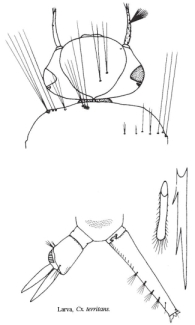Linnaeus used culex, the Latin word for mosquito when he described the common house mosquito, Culex pipiens. All mosquitoes described in the following 50 years were placed in this genus. In 1818 Meigen decided that there were at least two other major types of mosquito, which he therefore renamed and placed in the genera Anopheles and Aedes. Only three Culex species, one of which is pipiens, are known to occur in British Columbia.
The pale cuticle gives the adults an overall brown colour. The females can readily be separated from those of Anopheles by the short palps and trilobed scutellum, from those of Aedes by the blunt abdomen and from Culiseta and Mansonia females by the absence of both pre- and postspiracular setae.
Eggs are laid in rafts on the surface of almost any standing water.
Larvae have a long narrow respiratory siphon with a short pecten at the base composed of rather small teeth. The siphon lacks basal seta 1-S, but four or more pairs of branched setae arise ventrally beyond the pecten.
Pupae should be kept alive and allowed to emerge.
All our species overwinter as fertilized females and can produce several generations a year.
|
|
